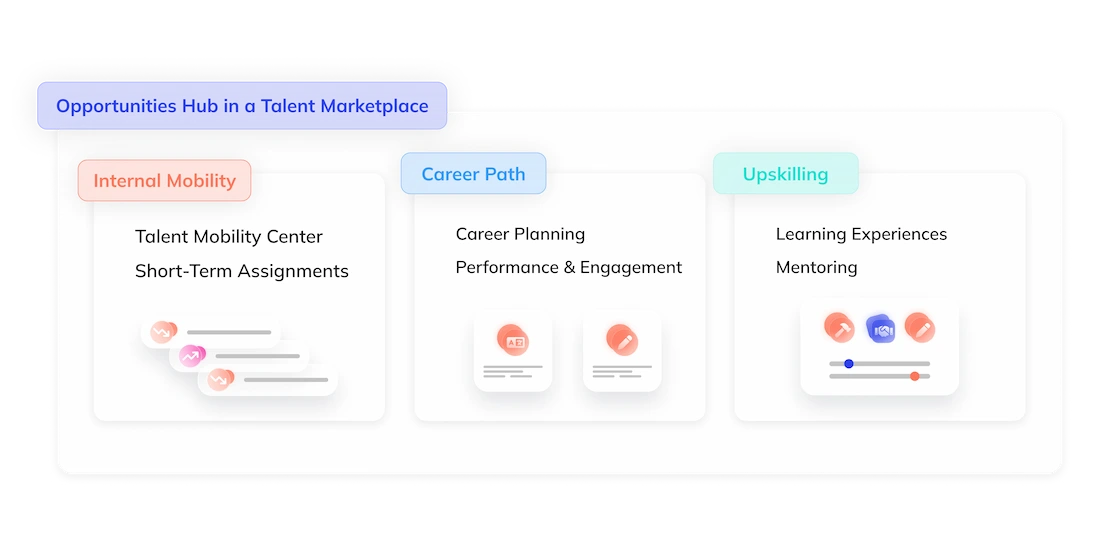Individualizing career paths is the main focus of career management research today. Taking into account individual preferences to build unique career paths is similar to personalizing the customer journey offering. 5 tips for individualizing career paths
Encouraging the Expression of Individual Aspirations
In today's war for talent, satisfying talent's desire to evolve is a challenge that requires authentic support in expressing their aspirations.
Tip #1: Aligning Views on Internal Opportunities
A study conducted by the Work Institute found that career development was the number one reason people leave or stay with a company. In addition, 51% of employees feel their company provides a clear path for career growth and advancement. This is in stark contrast to the 90% of employers who report clear management of career and mobility plans as an asset.
Why Do Employees and HR Professionals View Internal Career Opportunities Differently
The research indicates that the lack of a policy of building unique trajectories contributes to a high propensity for resignations.
The difference in perception of the career offer is explained by the manager's fear of seeing the talent leave. Managers fear that expressing their potential frustrations will keep them out of the "loop. Reducing this gap simply requires going beyond the emotional dimension of the employee-collaborator relationship. Anchor the organization in an objective approach to career development thanks to the two components of efficiency:
- skills and the quality of their allocation: read the guide on the management of skills for good practices.
- Motivation, its understanding and use in daily work: read our tips for measuring and improving motivation.
Tip number 2: Go for continuous conversations
Regular feedback with employees is now the norm, and managers must take care to prepare them well on different themes:
- Skills' evolutions
- Immediate development objectives
- The performance review
- Development needs and levers
Without denigrating the formalization of traditional HR procedures, continuous feedback is more in line with the desired close relationship.
Here are the steps in chronological order:
- Career interviews are held between managers and employees. They are a support for the career committees that take place later each year.
- Managers prepare their development needs and wishes before participating in career committees.
- The HR support budgets are subject to arbitration according to the developments and successions decided in a collegial manner.
The findings from career interviews feed into the HR service offering contained in your talent management system.
Break Down Barriers in Traditional Professions and Career Paths
Tip #3: Rethink the organization based on skills
We often hear about the Future of Work, it is already there:
81% of HR managers believe that the traditional roles underpinning work organization are now outdated
Considering a business as a set of skills rather than as a series of tasks to be carried out allows to release the potential of transversality of a company. The objectives become linked to common projects for the evolution of the business. Employees are considered in their individuality, and no longer defined solely by their work. Their skills and capacities can then be deployed in a fluid way, on projects corresponding to their interests and to the company's priorities.
Rigid job descriptions maintain the existence of organizational silos. Revisiting the organization as a network of skills mobilizable with common objectives is an imperative.
Tipnumber 4: Leverage Every Opportunity for Growth.
Many organizations offer a Learning Management System to new hires and existing employees. This top-down content is a first step, which should also include adaptation to their seniority level. The individualization of the coaching can intervene in the suggestion of the most appropriate training. We believe that its sustainability relies above all on the diffusion of a culture in which talents become actors of their evolution: the user selects a training that contributes to the advancement of his career.
Here are the 4 steps of the development opportunities valuation:
- Step 1 : The employee identifies the job offers or projects that inspire him/her within his/her "job cards" space. These positions are presented according to their proximity to their current skills .
- Step 2 : He selects the positions he wants to move towards within the galaxy of positions offered by the company. He/she becomes aware of the necessary skills .
- Step 3: The employee can then add this role to his or her career plan and look for training associated with the required skills .
- Step 4: Finally, he/she will receive a personalized training suggestion to access the envisaged role and thus apply.
Through this dynamic and transparent interface, employees can access personalized information about their career development plan.
The result? Employees get the attention and training they need and deserve, HR teams and managers show they are committed and care about their success. AI-enhanced career management tools can support and amplify these efforts by sharing the right training with the right employee at the right time to improve their skills and advance their career.
Embrace the Transformative Potential of AI
Tip #5: Deploy the Career Galaxy
Deloitte's "Global Human Capital" survey, gives the following assessment on the use of AI:
Although 71% of companies recognize AI as a critical trend, just 31% feel prepared for its implementation, indicating persistent apprehensions.
The Job Galaxy is the GPS for career management. Each employee has different skills and desires that the AI recognizes to offer 2 invaluable assets:
- A visualization of the possible trajectories from the current position.
- A detailed plan to access a target job.
We invite you to watch Carole Menguy, Head of Product & Innovation, present the galaxy of Neobrain's businesses.
How to Transition Smoothly into AI-Friendly Operations?
Moving to a first use of AI in HR requires 3 prior actions:
- Continue to strengthen the already existing European legislative framework on the use of AI in HR.
- Associate the Information Systems Department with the Human Resources Department in order to set up a common roadmap and acceptability criteria.
- Initiate, on a specific use case, a first proof of value in collaboration with an AI-based HR solution.
Artificial intelligence is no longer reserved for innovative groups, every organization can make it their own. The reserves and progress are gathered in our page dedicated to AI and Talent Management.
A Talent Marketplace with a powerful AI helps HR match skills, individual projects and strategic business priorities. The finer the granularity of information added to the AI, the more it can learn via machine learning to correctly associate these different elements.
Employees today demand more from their employers. By personalizing the career path of employees, they feel supported and valued. HR is more likely to retain and attract top talent, maximize ROI and increase employee engagement. When organizations personalize the employee experience with user-friendly Talent Marketplaces, they provide a seamless experience that builds employee loyalty, and helps them gain a competitive advantage.
Neobrain offers a space to share these skills, make them visible, develop them and thus contribute to collective performance: this is what we call a Talent Marketplace.















